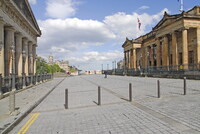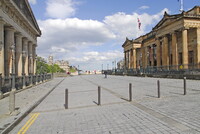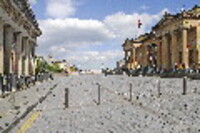| dc.coverage.spatial | Site: Edinburgh, Scotland, United Kingdom | en_US |
| dc.coverage.temporal | 1851-1859 (creation) | en_US |
| dc.creator | Playfair, William Henry | en_US |
| dc.date | 1851-1859 | en_US |
| dc.date.accessioned | 2013-09-16T20:06:24Z | |
| dc.date.available | 2013-09-16T20:06:24Z | |
| dc.date.issued | 1851-1859 | en_US |
| dc.identifier | 234196 | en_US |
| dc.identifier.other | archrefid: 2564 | en_US |
| dc.identifier.uri | http://hdl.handle.net/1721.3/141623 | |
| dc.description | The Mound, the Doric style Royal Institute (left) and the Ionic style National Gallery (right); The Mound was Playfair's greatest achievement, which he owed to his appointment as architect to the Board of Manufactures. Playfair began in 1822 with the Doric style Royal Institution, at the foot of the Mound, which he enlarged and ornamented in 1830. He closed his vista in 1846 with the Free Church College, with a Gothic exterior. In 1851, in the intervening space, he began to construct the Ionic style National Gallery of Scotland, which was his final architectural statement. The Mound perfectly unites the contrasting Gothic and Classical character of the Old and New Towns Source: Grove Art Online; http://www.oxfordartonline.com/ (accessed 6/29/2012) | en_US |
| dc.format.medium | sandstone | en_US |
| dc.rights | © Scott Gilchrist, Archivision, Inc. | en_US |
| dc.subject | architecture | en_US |
| dc.subject | decorative arts | en_US |
| dc.subject | Art museums | en_US |
| dc.subject | Nineteenth century | en_US |
| dc.subject | Neoclassical | en_US |
| dc.subject | Greek Revival | en_US |
| dc.title | National Gallery of Scotland | en_US |
| dc.title.alternative | Scottish National Gallery | en_US |
| dc.type | image | en_US |
| dc.rights.access | Licensed for educational and research use by the MIT community only | en_US |
| dc.identifier.vendorcode | 1A1-PWH-NGS-A8 | en_US |
| vra.culturalContext | British Scottish (Scots) | en_US |
| vra.technique | construction (assembling), carving (processes) | en_US |
| vra.worktype | art museum | en_US |
| dc.contributor.display | William Henry Playfair (British architect, 1790-1857) | en_US |



